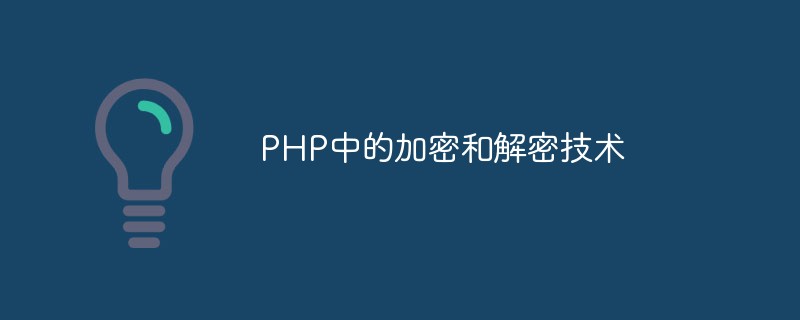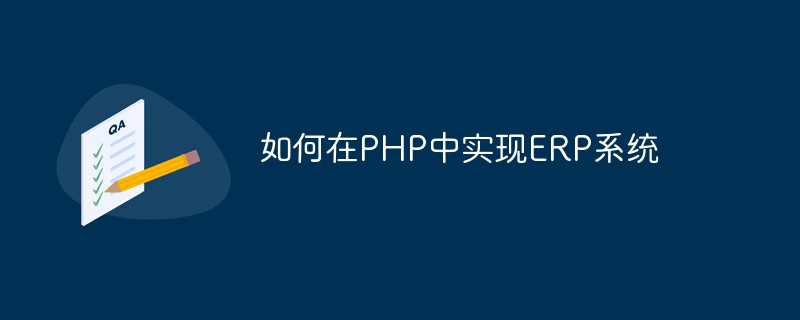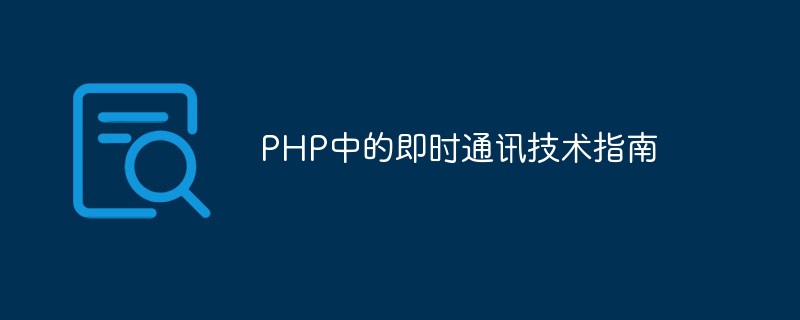In PHP programming, database query is an essential part, and query performance is the key optimization point. One direction in optimization is to cache query results to avoid repeated queries. This article will introduce practical methods for database query cache optimization.
1. Caching Principle
Caching query results is based on the principle of data immutability, that is, the same query results will not change before the data changes. Therefore, a query only needs to be executed once, and subsequent queries can be read from the cache. The implementation of caching is to store query results in memory and then query them by caching key-value pairs. In the implementation of cache, the time, capacity and cache update mechanism of cache storage need to be considered.
2. Cache implementation
- Memcached
Memcached is a common cache storage method that can be used in a variety of programming languages and web servers. The advantages are extreme speed and scalability. In PHP, caching of query results can be easily implemented through the Memcached extension. The following is a simple example code:
$cache = new Memcached();
$cache->addServer('localhost', 11211);
$key = md5('SELECT * FROM `table`');
$result = $cache->get($key);
if ($result === false) {
$result = // 执行查询操作
$cache->set($key, $result, 3600); // 缓存有效期1小时
}
// 使用查询结果- Redis
Redis is another common A cache storage method with more data structures and functions, such as storage structures, transactions and persistence. In PHP, you can easily cache query results through Redis extension. The following is a simple example code:
$redis = new Redis();
$redis->connect('localhost', 6379);
$key = md5('SELECT * FROM `table`');
$result = $redis->get($key);
if ($result === false) {
$result = // 执行查询操作
$redis->set($key, $result);
$redis->expire($key, 3600); // 缓存有效期1小时
}
// 使用查询结果3. Caching practice
- Only cache frequent query results
For results with fewer queries, caching may waste memory space. You can determine whether the query results are worth caching by setting a query threshold. For example, for a certain query result, if the number of queries exceeds 100 times within a period of time, it will be cached.
- Timeout update cache
Even if the data does not change, the query results may need to be updated because the cache time is too long. The cache expiration time can be set to a suitable interval, such as one hour. When the cache reaches the expiration time and is queried again, the cache will be automatically updated.
- Update cache manually
In some cases, the cache update process may be time-consuming, such as data update or deletion operations. In this case, you can use the manual cache update method, that is, clear the cache directly when the data is updated or deleted. This ensures the real-time nature of the cache.
4. Summary
In PHP programming, the optimization of database query cache is a very important part. By caching query results, query performance and server response speed can be greatly improved while avoiding repeated queries. In practice, different cache implementation methods and optimization technologies can be used according to actual conditions to achieve the best performance optimization effect.
The above is the detailed content of Database query cache optimization practice in PHP programming. For more information, please follow other related articles on the PHP Chinese website!
 如何在PHP中实现SEO优化May 20, 2023 pm 01:30 PM
如何在PHP中实现SEO优化May 20, 2023 pm 01:30 PM随着互联网的发展,SEO(SearchEngineOptimization,搜索引擎优化)已经成为了网站优化的重要一环。如果您想要使您的PHP网站在搜索引擎中获得更高的排名,就需要对SEO的内容有一定的了解了。本文将会介绍如何在PHP中实现SEO优化,内容包括网站结构优化、网页内容优化、外部链接优化,以及其他相关的优化技巧。一、网站结构优化网站结构对于S
 如何在PHP中实现多语言网站May 22, 2023 am 11:31 AM
如何在PHP中实现多语言网站May 22, 2023 am 11:31 AM随着互联网的日益普及,越来越多的网站需要支持多语言。这是因为网站的受众群体可能来自不同的地区和文化背景,如果只提供单一语言的网站,可能会限制访问者的数量和体验。本文将介绍如何在PHP中实现多语言网站。一、语言文件的创建和设计语言文件是存储所有文本字符串及其对应翻译的文件,需要以特定的格式创建。在创建语言文件时,需要考虑以下几个方面:1.命名和存储位置文件名应
 PHP中的加密和解密技术May 11, 2023 am 08:03 AM
PHP中的加密和解密技术May 11, 2023 am 08:03 AMPHP是一种被广泛应用的Web开发语言,其加密和解密技术在数据安全性方面具有重要意义。本文将介绍PHP中的加密和解密技术,并探讨其在Web应用程序中的实际应用。一、加密技术加密技术是一种将普通文本转换为加密文本的过程。在PHP中,加密技术主要应用于传输数据的安全性,例如用户的登录信息、交易数据等。PHP中常见的加密技术如下:哈希加密哈希加密是将一个任意长度的
 如何在PHP中实现ERP系统May 20, 2023 pm 06:21 PM
如何在PHP中实现ERP系统May 20, 2023 pm 06:21 PM随着电子商务和企业管理的发展,许多企业开始寻找更好的方法来处理其日常业务流程。ERP系统是一种能够整合企业各种业务流程的软件工具。它提供了全面的功能,包括生产、销售、采购、库存、财务等方面,帮助企业提高效率、控制成本和提高客户满意度。而在PHP编程语言中,也能够实现ERP系统,这就需要我们掌握一些基本的知识和技术。下面,我们将深入探讨如何在PHP中实现ERP
 PHP中的即时通讯技术指南May 22, 2023 pm 12:31 PM
PHP中的即时通讯技术指南May 22, 2023 pm 12:31 PM近年来,随着互联网技术的不断发展,即时通讯技术成为了各个领域中不可或缺的一部分,而在Web开发中,PHP作为一种广泛应用的服务器端脚本语言,也开始探索并应用即时通讯技术。本文将围绕PHP中的即时通讯技术,从通讯协议、技术方案、应用场景三个方面进行介绍和指南。一、通讯协议HTTP协议HTTP协议是Web开发中最常用的协议之一,适用于上传、下载、浏览网站等场景。
 如何在PHP中使用闭包函数May 18, 2023 pm 05:30 PM
如何在PHP中使用闭包函数May 18, 2023 pm 05:30 PMPHP闭包函数是指在声明函数时所定义的函数体内部所使用的变量和外部环境中的变量形成一个封闭的作用域,这种函数又被称为匿名函数。闭包函数在PHP中被广泛应用,可以用于实现事件处理、回调等一系列功能。本文将介绍如何在PHP中使用闭包函数,以及一些使用闭包函数的最佳实践。一、如何定义一个闭包函数定义一个闭包函数非常简单,只需要使用函数关键字followedby
 如何在PHP中使用机器人函数May 18, 2023 pm 10:00 PM
如何在PHP中使用机器人函数May 18, 2023 pm 10:00 PM最近,随着人工智能技术的快速发展,机器人技术也逐渐得到了广泛的应用,其中,机器人函数成为了PHP编程语言中一个非常实用的工具。本文将介绍如何在PHP中使用机器人函数。什么是机器人函数机器人函数指在PHP编程语言中用于模拟机器人行为的一组函数。这些函数包括move()、turn()等,可以让我们编写出模拟机器人运动、转向等相关操作的代码。在实际应用中,机器人函
 PHP中如何进行移动端应用开发?May 13, 2023 am 08:21 AM
PHP中如何进行移动端应用开发?May 13, 2023 am 08:21 AM近年来,随着移动设备的普及和移动互联网的蓬勃发展,越来越多的企业和开发者开始把注意力放在移动端应用上。而PHP作为一种流行的Web开发语言,同样有着不少的移动端应用开发需求。那么,PHP中如何进行移动端应用开发呢?一、了解移动端应用在开始PHP移动端应用开发之前,我们首先需要了解移动端应用的特点和要求。相较于Web网站,移动端应用有着更高的用户体验要求和更严


Hot AI Tools

Undresser.AI Undress
AI-powered app for creating realistic nude photos

AI Clothes Remover
Online AI tool for removing clothes from photos.

Undress AI Tool
Undress images for free

Clothoff.io
AI clothes remover

AI Hentai Generator
Generate AI Hentai for free.

Hot Article

Hot Tools

mPDF
mPDF is a PHP library that can generate PDF files from UTF-8 encoded HTML. The original author, Ian Back, wrote mPDF to output PDF files "on the fly" from his website and handle different languages. It is slower than original scripts like HTML2FPDF and produces larger files when using Unicode fonts, but supports CSS styles etc. and has a lot of enhancements. Supports almost all languages, including RTL (Arabic and Hebrew) and CJK (Chinese, Japanese and Korean). Supports nested block-level elements (such as P, DIV),

SublimeText3 Linux new version
SublimeText3 Linux latest version

Notepad++7.3.1
Easy-to-use and free code editor

PhpStorm Mac version
The latest (2018.2.1) professional PHP integrated development tool

Dreamweaver CS6
Visual web development tools






